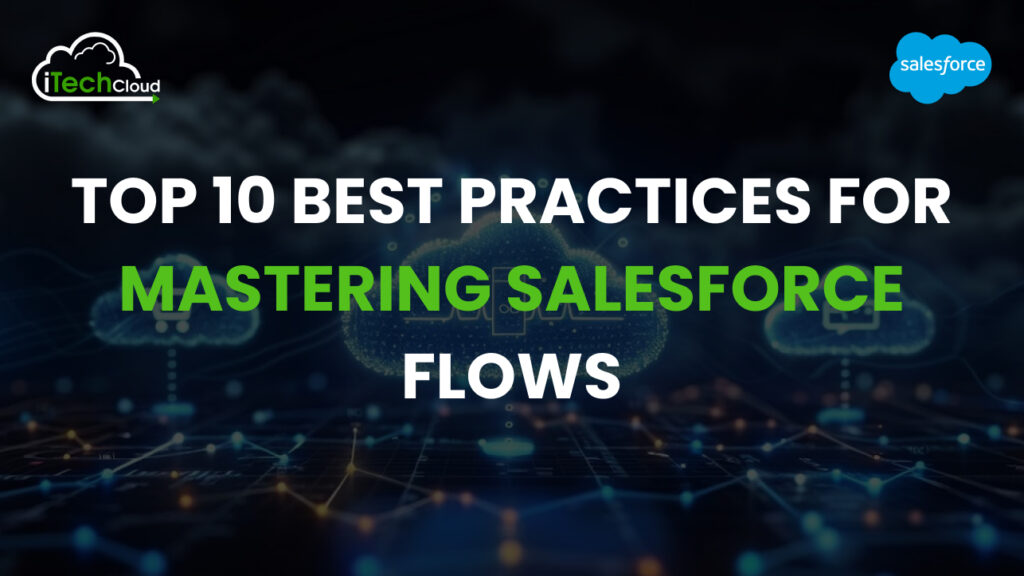Top 10 Best Practices for Mastering Salesforce Flows

Salesforce Flows are a powerful automation tool that allows admins and developers to streamline business processes without writing extensive code. Whether you’re automating simple tasks or building complex business logic, following best practices ensures efficiency, scalability, and maintainability.
In this blog, we’ll explore the top 10 best practices for mastering Salesforce Flows, helping you design, build, and optimize flows like a pro.
Table of Contents
1. Choose the Right Type of Flow
Salesforce offers several types of flows, each suited for different use cases:
- Screen Flows – Best for guided user interactions (e.g., onboarding, data collection).
- Autolaunched Flows – Triggered automatically (e.g., Process Builder, Apex, or record changes).
- Scheduled Flows – Run at specified times (e.g., batch updates).
- Record-Triggered Flows – Execute on record creation, update, or deletion (replacing Workflow Rules and Process Builder).
Best Practice:
- Use Record-Triggered Flows for most automation needs (they’re faster and more efficient than Process Builder).
- Avoid mixing flow types unnecessarily choose the simplest option that meets requirements.
2. Optimize Flow Triggers to Avoid Recursion
Recursion occurs when a flow triggers itself repeatedly, leading to performance issues or governor limit errors.
Best Practices:
- Use $GlobalConstant.IS_CHANGED or ISNEW() to prevent infinite loops.
- Set entry conditions to ensure the flow runs only when necessary.
- Avoid updating the same field that triggered the flow unless absolutely necessary.
3. Use Variables and Formulas Efficiently
Flows support variables (text, number, Boolean, etc.) and formulas to store and manipulate data.
Best Practices:
- Use resource names that are clear and consistent (e.g., AccountName instead of var1).
- Leverage formulas for calculations instead of multiple assignment elements.
- Store frequently used values in variables to avoid redundant queries.
4. Minimize SOQL Queries and DML Operations
Salesforce imposes governor limits, so inefficient queries can cause errors.
Best Practices:
- Use Get Records with filters instead of retrieving all records and filtering in the flow.
- Combine multiple updates into a single DML operation (e.g., use a collection variable).
- Avoid querying inside loops fetch data first, then process it.
5. Implement Error Handling
Flows can fail due to validation rules, missing data, or system errors. Proper error handling ensures smooth execution.
Best Practices:
- Use fault paths in flow elements to handle exceptions.
- Add decision elements to validate data before processing.
- Log errors in a custom object or send notifications via email alerts.
6. Keep Flows Modular and Reusable
Complex flows can become hard to maintain. Breaking them into smaller, reusable components improves efficiency.
Best Practices:
- Use subflows for repeated logic (e.g., sending notifications, updating fields).
- Create utility flows for common functions (e.g., address validation, status updates).
- Document each flow’s purpose and dependencies.
7. Test Thoroughly Before Deployment
Flows can impact multiple processes, so rigorous testing is essential.
Best Practices:
- Test in a sandbox with real-world data scenarios.
- Check for bulk record handling (200+ records).
- Validate edge cases (empty fields, invalid inputs).
8. Monitor and Optimize Flow Performance
Slow flows can degrade user experience.
Best Practices:
- Use Flow Debug to identify bottlenecks.
- Review Flow Interview Logs in Setup for errors.
- Optimize queries, reduce unnecessary steps, and limit screen interactions.
9. Document and Organize Flows
Proper documentation ensures maintainability.
Best Practices:
- Add descriptions to each flow and element.
- Use a naming convention (e.g., “Account_UpdateStatus_Auto”).
- Maintain a flow inventory with dependencies.
10. Stay Updated with Salesforce Flow Enhancements
Salesforce frequently releases new Flow features.
Best Practices:
- Follow Salesforce Release Notes for updates.
- Learn Flow Builder’s latest capabilities (e.g., loops, error handling improvements).
- Join Trailhead and Salesforce communities for best practices.
Conclusion: Mastering Salesforce Flows
Mastering Salesforce Flows requires a mix of strategic planning, efficient design, and continuous optimization. By following these 10 best practices, you can build scalable, high-performance flows that automate processes seamlessly while avoiding common pitfalls.

